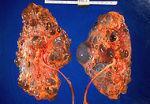New Ultrasound Criteria for ADPKD

A research team led by Dr. York Pei of the University of Toronto reported that at-risk individuals for ADPKD often receive ultrasound screening employing diagnostic criteria created from individuals with mutations in the polycystic kidney disease 1 (PKD1) gene. However, families with mutations in the PKD2 gene typically have less severe disease, suggesting the potential need for different diagnostic criteria.
"The diagnostic criteria currently in use performed suboptimally for individuals with mutations in PKD2 as a result of reduced test sensitivity," the authors noted.
The multi-institutional study group assessed 577 at-risk individuals from 58 PKD1 families and 39 PKD2 families using renal ultrasound and molecular genotyping. At the time of their ultrasound scan, 31.5% (299 of 948), 55.3% (524 of 948), and 13.2% (125 of 948) of the study participants were 15 to 29 years of age, 30 to 59 years, and greater than or equal to 60 years, respectively, according to the authors. Based on their genotype, 52.3% (496 of 948) of the study participants were considered affected.
The authors determined that in families of unknown genotype, the presence of three or more (unilateral or bilateral) renal cysts is sufficient to establish the diagnosis of ADPKD in individuals ages 15 to 39, yielding a positive predictive value of 100%. Two or more cysts in each kidney are sufficient for individuals ages 40 to 59, while four or more cysts in each kidney are required for individuals 60+, according to the authors.
"Conversely, fewer than two renal cysts in at-risk individuals aged 40+ yrs is sufficient to exclude the disease," the authors concluded. "These unified diagnostic criteria will be useful for testing individuals who are at risk for autosomal dominant polycystic kidney disease in the usual clinical setting in which molecular genotyping is seldom performed."
The authors also noted that the utility of ultrasound to exclude disease may be limited in at-risk individuals who are younger than 30 and have a negative or indeterminate scan.
This genetic testing could be performed by linkage analysis using polymorphic PKD1 and PKD2 markers if multiple affected and unaffected family members are available, according to the authors. Mutation screening of PKD1 and PKD2 could also be performed as an alternative.
"Because the sensitivity for PKD2 mutation detection is at least 80% and most affected individuals with equivocal ultrasound results will have the milder PKD2 disease, gene-based testing is expected to provide reasonable diagnostic utility in this special target group," the authors wrote.